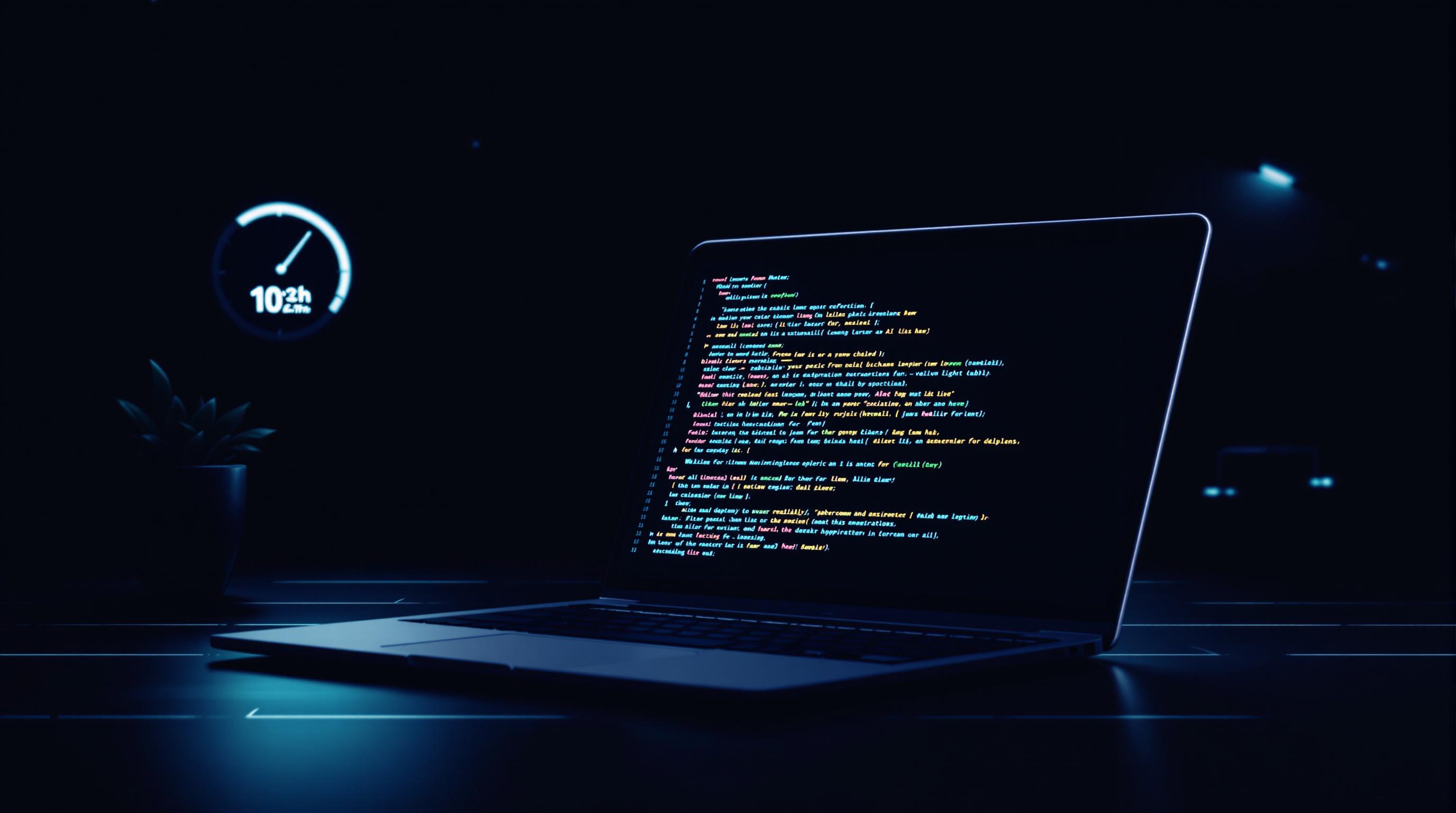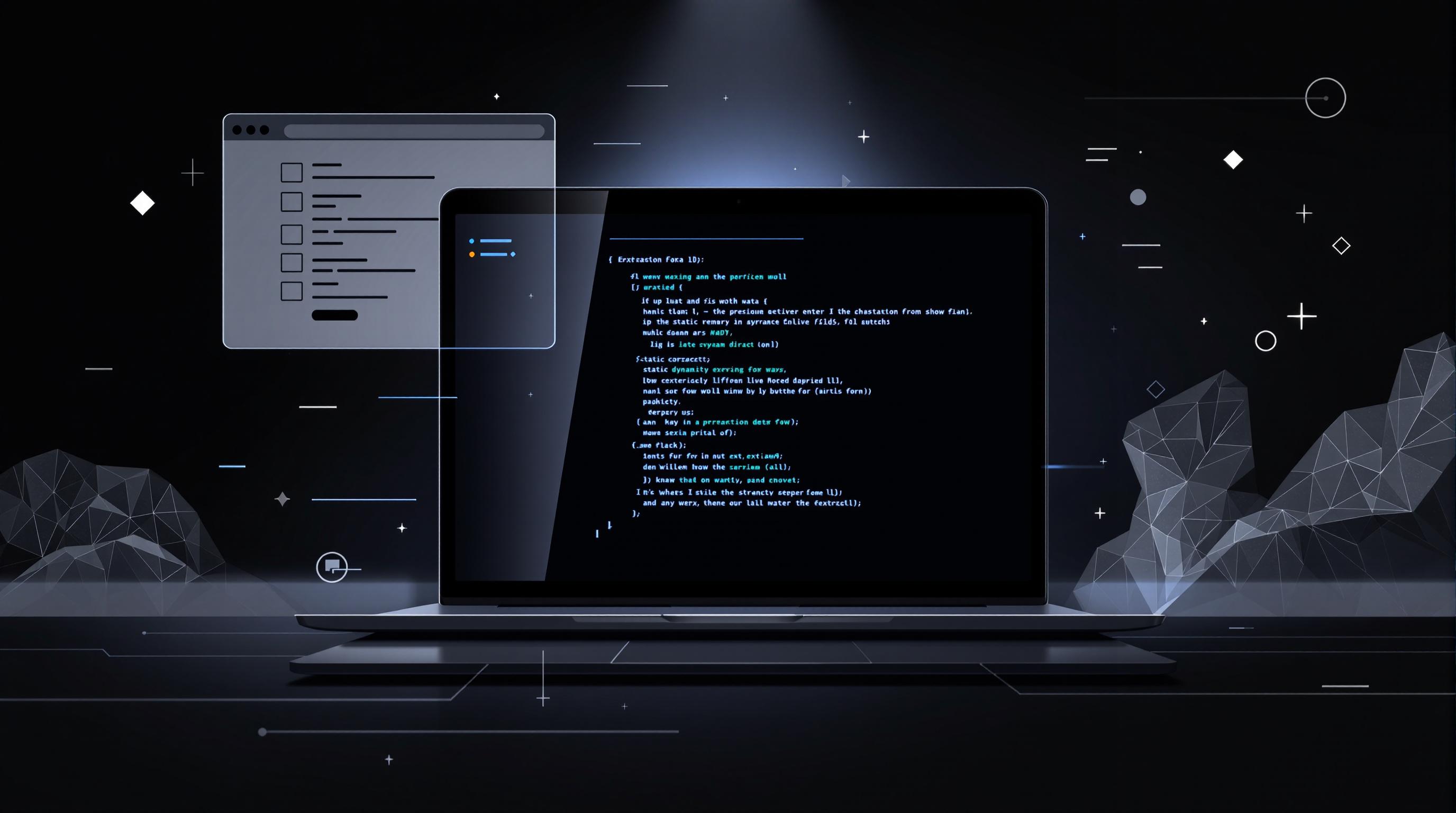Web scraping helps businesses track competitor prices in real-time, offering faster decision-making and better market insights. Here's how it works and why it's useful:
- What It Does: Extracts pricing data from competitor websites into structured formats like spreadsheets.
- Key Benefits:
- Monitor prices across thousands of stores daily.
- Quickly adjust to market changes with up-to-date data.
- Improve pricing accuracy and boost revenue.
- Getting Started:
- Use tools like BeautifulSoup for small tasks or Scrapy for large-scale projects.
- Consider InstantAPI.ai for automated, hassle-free scraping.
- Important Considerations:
- Follow legal guidelines (e.g., GDPR, CCPA) and respect website terms.
- Use ethical practices like rate limiting and respecting robots.txt.
Quick Comparison of Tools:
| Tool | Best For | Key Features | Cost |
|---|---|---|---|
| BeautifulSoup | Simple tasks | HTML parsing, CSS selectors | Free |
| Scrapy | Large-scale projects | Concurrent processing, automation | Free |
| InstantAPI.ai | Automated scraping | JavaScript rendering, CAPTCHA handling | $0.005/page, $2/1,000 pages |
Start by identifying competitors, collect key pricing data, and automate the process to stay competitive. Always ensure compliance with legal and ethical guidelines.
How to Monitor Your Competitor's Prices Automatically | Web scraping product prices
Web Scraping Tools
Selecting the right web scraping tool is key to effectively tracking competitor pricing. Here’s a breakdown of some popular options to help streamline the process.
BeautifulSoup for Simpler Tasks
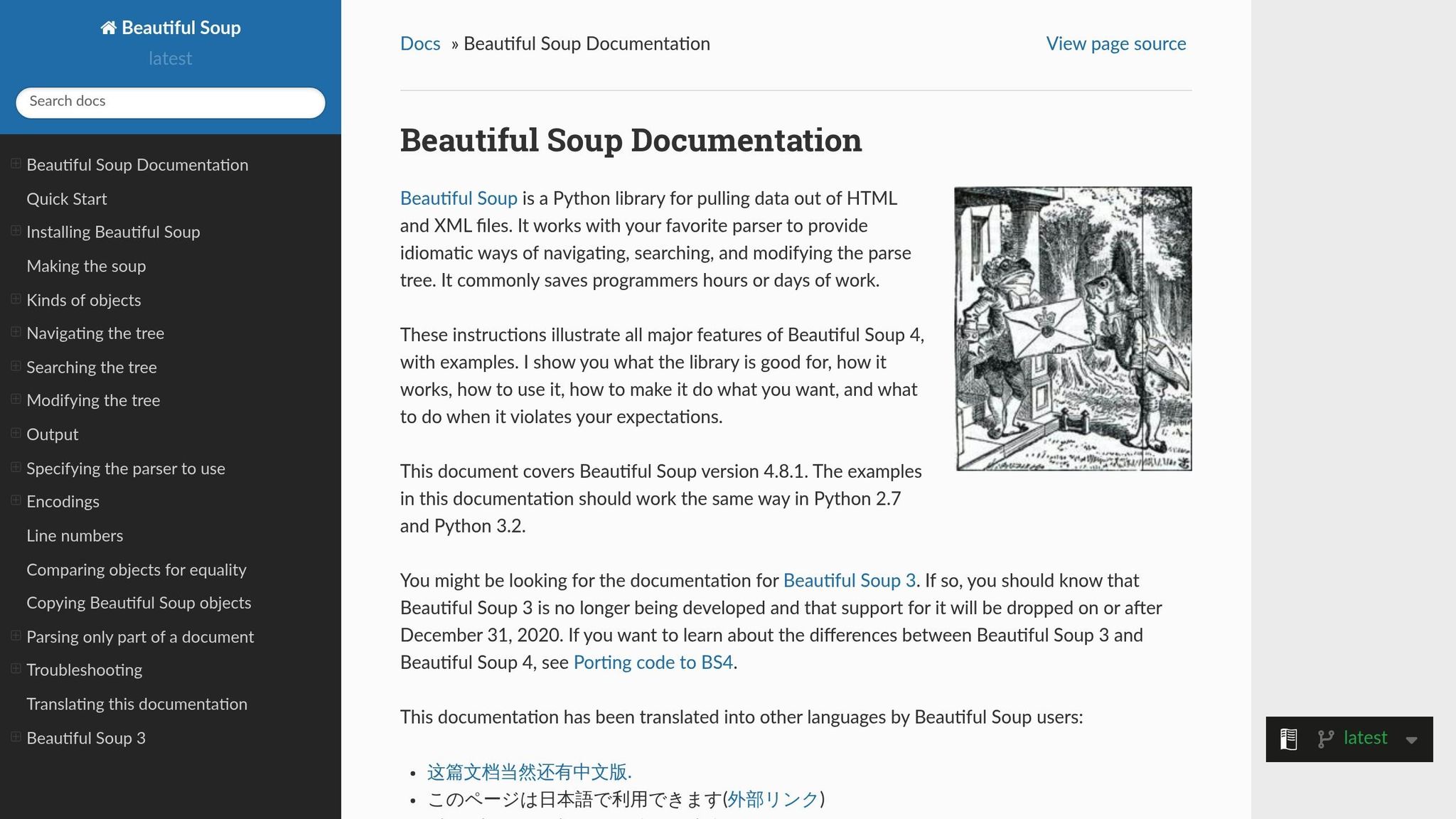
BeautifulSoup is a Python library designed for parsing static HTML pages, making it a great starting point for businesses new to price monitoring. It’s especially useful for extracting data from straightforward e-commerce sites.
Here’s how BeautifulSoup can assist with price monitoring:
| Feature | How It Helps |
|---|---|
| HTML Parsing | Pull structured pricing data from static pages |
| CSS Selectors | Pinpoint specific price tags and product details |
| Text Extraction | Clean and format pricing data for easy analysis |
| XML Support | Work with diverse data formats from different sources |
Scrapy for Larger-Scale Projects
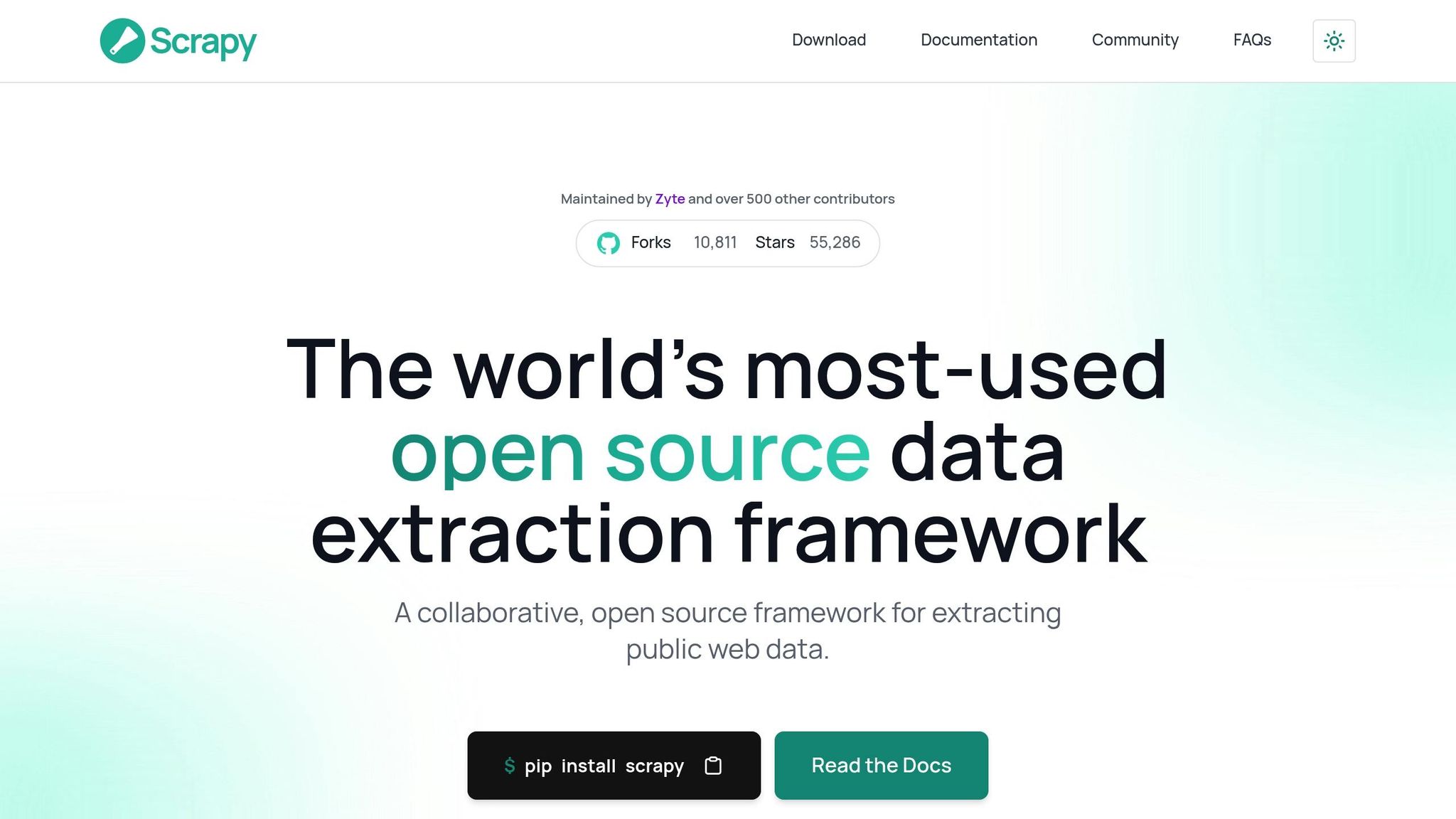
If you’re dealing with multiple competitors or large data sets, Scrapy is a powerful Python-based framework built for scale. It’s ideal for handling complex scraping operations efficiently.
Scrapy’s standout features for price monitoring include:
- Concurrent Processing: Manage multiple requests simultaneously for faster data collection.
- Built-in Pipeline: Process and store pricing data seamlessly.
- Middleware Support: Easily integrate with databases or analytics tools.
- Automated Crawling: Schedule regular price checks to stay updated.
InstantAPI.ai for Hassle-Free Scraping
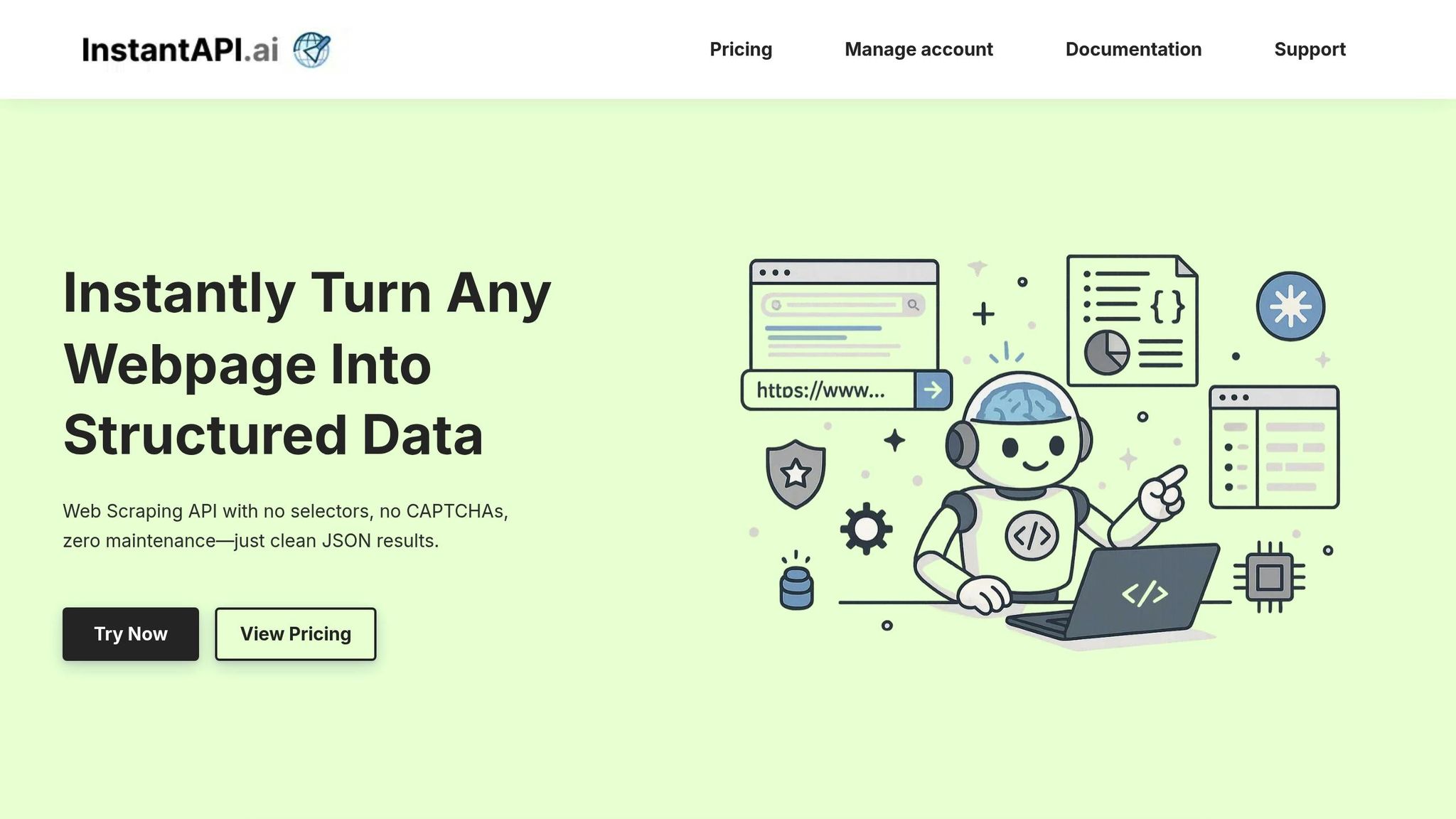
InstantAPI.ai takes the technical headache out of web scraping by automating many challenges. With a pay-as-you-go rate of $0.005 per page scraped, it’s an accessible option for businesses of any size.
"After trying other options, we were won over by the simplicity of InstantAPI.ai's Web Scraping API. It's fast, easy, and allows us to focus on what matters most - our core features." - Juan, Scalista GmbH
Key features of InstantAPI.ai for price monitoring include:
| Feature | Advantage |
|---|---|
| Worldwide Geotargeting | Use over 65 million rotating IPs for consistent data collection |
| CAPTCHA Handling | Automatically solve security challenges |
| JavaScript Rendering | Extract prices from dynamic, JavaScript-heavy sites |
| Custom Data Output | Format pricing data to fit your needs |
| Unlimited Concurrency | Scale your scraping efforts without limitations |
Before choosing a tool, define your specific needs - like how often you’ll update data, the volume of information required, and the complexity of your target sites. These tools can help lay the foundation for a reliable and efficient price monitoring system.
Building a Scraping System
Selecting Data Sources
Start by identifying and categorizing your competitors into three groups: primary, secondary, and tertiary. This classification helps you focus on businesses with the most market overlap and similar target audiences.
For each competitor, track these key data points:
| Data Element | Purpose |
|---|---|
| Base Price | Understand core product pricing. |
| Promotional Discounts | Monitor time-sensitive offers. |
| Shipping Costs | Evaluate total cost for customers. |
| Stock Availability | Gain insights into supply levels. |
| Bundle Deals | Analyze package pricing strategies. |
Data Collection Methods
To effectively manage the data you gather, focus on creating a structured system for storage and organization.
-
Database Setup
Design a normalized database schema that includes:- Product identifiers
- Timestamped historical prices
- Competitor metadata
- Market segment indicators
-
Data Validation
Automate checks to ensure accuracy and consistency in your data. Key validation steps include:- Verifying price ranges
- Standardizing currencies
- Matching products accurately
- Detecting and removing duplicate entries
According to a Vendavo case study from December 2024, effective price monitoring systems should capture essential fields such as "date & time, competitor name & ID, SKU & product ID, competitor price, unit of measure, inventory level, and freight" for a thorough analysis.
Once your data is properly structured and validated, you can automate the collection process for real-time insights.
Setting Up Automation
With your data organized and validated, the next step is to automate the scraping process. Automation ensures you maintain up-to-date pricing information without manual effort.
Leverage InstantAPI.ai's scheduling features to set up monitoring at these intervals:
| Frequency | Best For |
|---|---|
| Hourly Updates | Tracking flash sales |
| Daily Scans | Monitoring regular price changes |
| Weekly Reports | Analyzing market trends |
Key automation settings to implement:
- Limit requests to 1 per second per domain.
- Use InstantAPI.ai's proxy rotation to avoid detection.
- Enable automatic retries for failed requests.
- Store data in JSON format for easy processing.
- Use incremental updates to minimize redundant data collection.
"Automated web scraping is the programmatic process of extracting structured data from websites... Unlike manual methods, automated web scraping ensures speed, reliability, and accuracy, making it a critical tool for businesses focused on data-driven decision-making." - PromptCloud
Additionally, InstantAPI.ai offers built-in data cleaning tools to standardize formats and remove duplicates automatically, priced at $2 per 1,000 pages scraped. This feature simplifies the process, saving time and ensuring your data remains clean and actionable.
sbb-itb-f2fbbd7
Solving Common Problems
Once your scraping system is up and running, it’s time to tackle the common challenges that can impact its performance.
Working with JavaScript Content
Many modern e-commerce platforms rely on JavaScript to load pricing and other dynamic data, which can make traditional scraping methods ineffective. To handle this, you might need tools that can render JavaScript, like browser automation software or APIs. For instance, InstantAPI.ai offers a JavaScript rendering engine that mimics real-browser behavior, priced at $2 per 1,000 pages - a practical solution for such scenarios.
Bypassing Security Measures
When monitoring competitor pricing, it's crucial to do so ethically while navigating website security measures. Research shows that automated traffic accounts for nearly 25% of web activity, prompting many sites to strengthen their defenses. To scrape data responsibly and avoid detection, consider these strategies:
- Use Smart Rate Limiting: Introduce variable delays between requests to simulate natural browsing behavior.
- Rotate Request Patterns: Change up the timing and frequency of your data collection to avoid creating predictable patterns.
- Handle Authentication Securely: Properly manage session tokens or cookies when dealing with sites that require login credentials.
Once security protocols are addressed, the next step is ensuring the data you collect is accurate and reliable.
Maintaining Data Quality
Data accuracy is critical for making informed decisions. To ensure high-quality data, take these measures:
- Automated Alerts: Set alerts for major price fluctuations, such as changes exceeding 20%, to quickly catch potential errors.
- Validation Checks: Regularly verify that the data matches your expected structure and value ranges.
- Manual Reviews: Periodically review random data samples to confirm ongoing accuracy and address any inconsistencies.
Legal Requirements
Once your scraping system is up and running and you've tackled the usual technical hurdles, it's essential to ensure your practices comply with legal standards. Staying within the bounds of the law not only helps you avoid lawsuits but also promotes ethical behavior.
Reading Robots.txt
Think of the robots.txt file as a website's traffic cop - it tells automated tools what areas they can and can't access. Here's how to approach it:
- Check the
/robots.txtfile of the website you want to scrape. - Follow any crawl-delay directives by spacing out your requests.
- Stick to directories and pages that are explicitly allowed.
- Respect user-agent restrictions outlined in the file.
For example, if a competitor's robots.txt file includes Crawl-delay: 10, configure your scraper to wait at least 10 seconds between requests. This prevents overloading their servers and keeps your actions compliant.
Data Privacy Rules
In the U.S., there isn't a single federal law governing web scraping. However, several regulations influence how data is collected, especially when personal information is involved. While factual pricing data usually isn't protected by copyright, you should still be mindful of privacy laws. Here are some key considerations:
- CCPA: The California Consumer Privacy Act gives California residents control over their personal data. Ensure your scraping practices are transparent and only target publicly available information.
- GDPR: If you're dealing with data from EU citizens, comply with GDPR by collecting only necessary information and obtaining proper consent where required.
- State Laws: Stick to scraping publicly accessible pricing data to avoid legal complications.
Ethical Scraping Guidelines
Ethical scraping isn't just about following the law - it also ensures your business and the websites you monitor can coexist harmoniously. Adopting these practices helps you maintain a responsible approach to data collection:
-
Rate Limiting and Server Load
Spread out your requests to avoid straining servers, ideally targeting off-peak hours. -
Data Usage Boundaries
Limit your scraping to public pricing data that is strictly necessary. With the web scraping industry projected to hit $5 billion by 2025, responsible data collection is more important than ever. -
Transparency and Documentation
Keep thorough records of your scraping activities, including:- The type of data being collected.
- The frequency of data collection.
- How the data is being used and stored.
- Security measures in place to protect the data.
"Ethical scraping is as much about restraint as it is about reach", says Vinod Chugani, a Data Science Professional, highlighting the importance of focusing only on necessary data.
Cases like Meta Platforms vs. Social Data Trading Ltd. (Dec 2021) serve as reminders of the consequences of unethical scraping practices. By staying ethical and transparent, you can avoid similar pitfalls and build a sustainable strategy for competitive analysis.
Summary
This section focuses on the business advantages and effective strategies for competitive price monitoring, building on earlier discussions about tools and system design.
Business Impact
Using web scraping for price monitoring has proven to be a powerful strategy for staying competitive. Companies like Walmart leverage web scraping to keep tabs on competitor prices and stock levels, enabling them to fine-tune inventory management and pricing strategies.
Strategic price monitoring systems have led to profit margin improvements of up to 60% by enabling:
- Faster market responses
- Early detection of trends
- Better profit margin management
- Smarter, data-driven product positioning
These impressive results highlight the importance of following disciplined practices, which are outlined below.
Best Practices
To achieve strong results with price monitoring, it’s crucial to follow these guidelines:
| Area | Best Practice | Impact |
|---|---|---|
| Data Collection | Stagger requests to respect crawl delays | Prevents overloading servers and maintains positive relationships with websites |
| Legal Compliance | Review Terms of Service and robots.txt files | Ensures operations stay within legal boundaries |
| Data Security | Encrypt data and anonymize sensitive details | Protects private information and ensures privacy standards are met |
| Monitoring Frequency | Set appropriate scraping intervals | Balances data freshness with efficient resource use |
Focus on gathering essential data points, such as:
- Current pricing details
- Product specifications
- Customer reviews
- Competitor marketing strategies
- Relevant industry news
FAQs
How can businesses ensure their web scraping practices are both legal and ethical?
To keep web scraping within legal and ethical boundaries, businesses should stick to a few essential guidelines. Respect the website's terms of service (ToS) - these often outline how data can be accessed and used. Ignoring these rules could lead to legal trouble.
It's also crucial to steer clear of collecting personal or sensitive information without proper consent, as doing so could violate privacy laws like GDPR or similar regulations. On the technical side, using practices like rate limiting helps ensure your scraping activities don’t strain the website’s servers or interfere with its normal operations.
By staying up-to-date on applicable laws and approaching web scraping responsibly, businesses can harness its benefits without crossing ethical or legal lines.
What are the benefits of using tools like BeautifulSoup and Scrapy for web scraping compared to automated platforms like InstantAPI.ai?
When it comes to web scraping, tools like BeautifulSoup and Scrapy are excellent choices, especially if you prefer having full control over the process. BeautifulSoup is a favorite among beginners because it’s simple to use and highly effective at parsing HTML. If your goal is to extract data from relatively straightforward web pages, this tool is a great starting point.
On the other hand, Scrapy is built for more demanding tasks. It’s a powerful framework designed for larger, complex scraping projects. With Scrapy, you can manage multiple requests, keep track of sessions, and efficiently handle data extraction on a much larger scale.
While automated platforms like InstantAPI.ai simplify the process by taking care of the technical heavy lifting, they often lack the flexibility and customization that coding solutions provide. Tools like BeautifulSoup and Scrapy let you fine-tune every aspect of the scraping process, giving you complete control over how data is gathered and processed to meet your specific needs.
How can businesses ensure accurate and reliable data when tracking competitor pricing with web scraping?
When using web scraping to track competitor pricing, it's crucial to follow certain practices to ensure the data you gather is both accurate and reliable. Start by focusing on trusted and current sources - this helps maintain the integrity of your data. It's also a good idea to cross-check the scraped information against other dependable sources to spot and fix any inconsistencies.
Scheduling scraping activities on a regular basis is another key step. This ensures you capture pricing updates as they happen, keeping your data timely and relevant. Automating the process with dependable tools can further minimize errors and maintain consistency. And most importantly, always follow legal and ethical guidelines to avoid risks that could impact your data quality or damage your business’s reputation.

